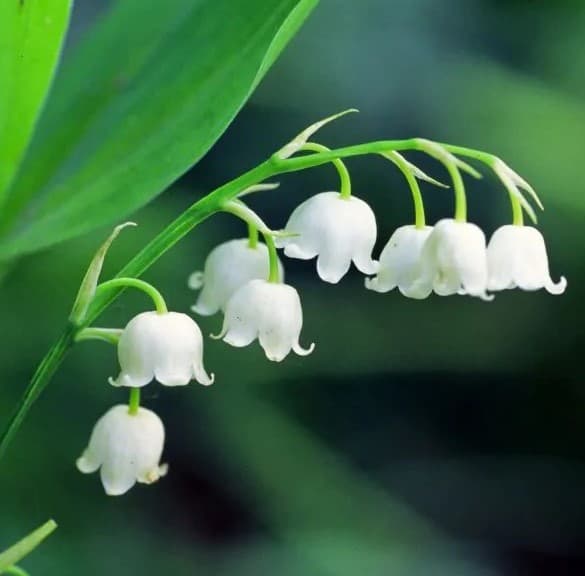How to Grow Convallaria Flowers - Lily of the Valley

About Growing Convallaria Flowers in Your Home Flower Garden
Looking for an effortless bloomer that grows well where the sun won’t shine? Then, growing Convallaria flowers are the perfect choice for your shade garden. Lily of the Valley grows best in shady areas. Native to Asia, Europe, and North America, Convallaria plants make a great ground cover on the north side of houses and buildings. In addition to shade gardens, you can grow them in containers on your balcony or deck. And, you can grow them indoors, too.
Lily of the Valley plants grow 6 to 12 inches high. They bloom in late spring. Most varieties are white. There are less common rose or pink varieties of this flower. Convallaria’s bell-shaped flowers produce a strong, pleasant fragrance. The flowers are long bloomers. Blooming begins in the spring and can last through the summer.
Convallaria is a toxic plant. However, when prepared and used properly it has medicinal benefits. The plant is used for diuretic, sedative, and anti-inflammatory purposes.
Tip: Try growing Lily of the Valley indoors in the winter. Also, see How to force blooms indoors
Did you Know? When in season, Lily of the Valley is popular in wedding bouquets. Kate Middleton’s bridal bouquet included lily of the Valley flowers.
Flowers Bloom: Late Spring to Early Summer.
Flower Colors: White is by far the most common color. Uncommon colors include pink and rose.
Plant height: 6 to 12 inches tall.
Plant Hardiness Zones: 2 – 9
Did You Know? Lily of the Valley is a symbol of good luck and happiness.
Convallaria Flower Plant Propagation
Lily of the Valley can be propagated from seed or their rhizomes. Seeds can take months to germinate. So, most people propagate them using rhizomes. Make sure there is at least one bud “Eye” on each rhizome. Plant them with the eye on top of the rhizome.
While the plants can be grown from seeds, it is rather difficult. The seeds take from two months to a year to germinate. So, most gardeners propagate the plants using the rhizomes.
The plants look their best growing in groups.
Dig up rhizomes of established plants in the Spring or Fall and separate them into clumps for re-planting.
Rhizome Planting Depth: Plant rhizomes 2 to 3 inches deep.
Final Plant Spacing: 4 to 6 inches apart. They tolerate a little crowding. However, plants and flowers are smaller when overcrowded.
How to Grow Convallaria Flowers
Lily of the Valley is very easy to grow. Established plants will grow and thrive for many years. The plants prefer partial to dappled shade. They do not do well in full sun. Convallaria thrives in moderate climates. They do not do well in hot, dry regions.
Lily of the Valley makes for a good ground cover in shady areas. However, the plants are mildly invasive. A sidewalk or driveway is a good border. Also, consider border edging in other areas to limit their spread.
Lily of the Valley plants tolerate poor and heavy clay soils. Like any plant, they will grow better if fertilized. Do so in early spring, and again after the blooms have died off. The plants prefer loose, well-drained soils.
Space the plants about 12″ apart. Over time they will spread out to fill in empty spaces.
The plants like moist soil. Water them in dry weather.
If blooms are few and far between, the plants may be overcrowded. This is easily fixed by digging the rhizomes up and replanting them. In poor soils, a lack of phosphorous can keep them from blooming. You do not need to prune or deadhead spent blooms. Of course, remove any dead leaves, to improve the appearance of the plant.
After a few years, the clumps of flowers should be separated. Divide and separate plants in the Fall. First, dig up the rhizomes. Then, separate the rhizomes into clumps, using a sharp knife. Make sure at least one “eye” is on each segment. Finally, replant the rhizomes, spacing them four to six apart.
Ideal Soil pH: 6.1 – 7.1.
Insects and Plant Disease
Convallaria plants are seldom bothered by insects or plant disease. Aphids and mites can be an occasional problem. Uncommon plant diseases fungal leaf spots, stem rot and anthracnose.
Related Articles
Also, people who read this article will like:
Flower Gallery Find pictures of your favorite flowers
Please support our site. Shop for:
- rmmatthews100@hotmail.com
- 585-721-6528
- Rochester, NY
©1999-2024 GardenersNet.Com, All Rights Reserved

